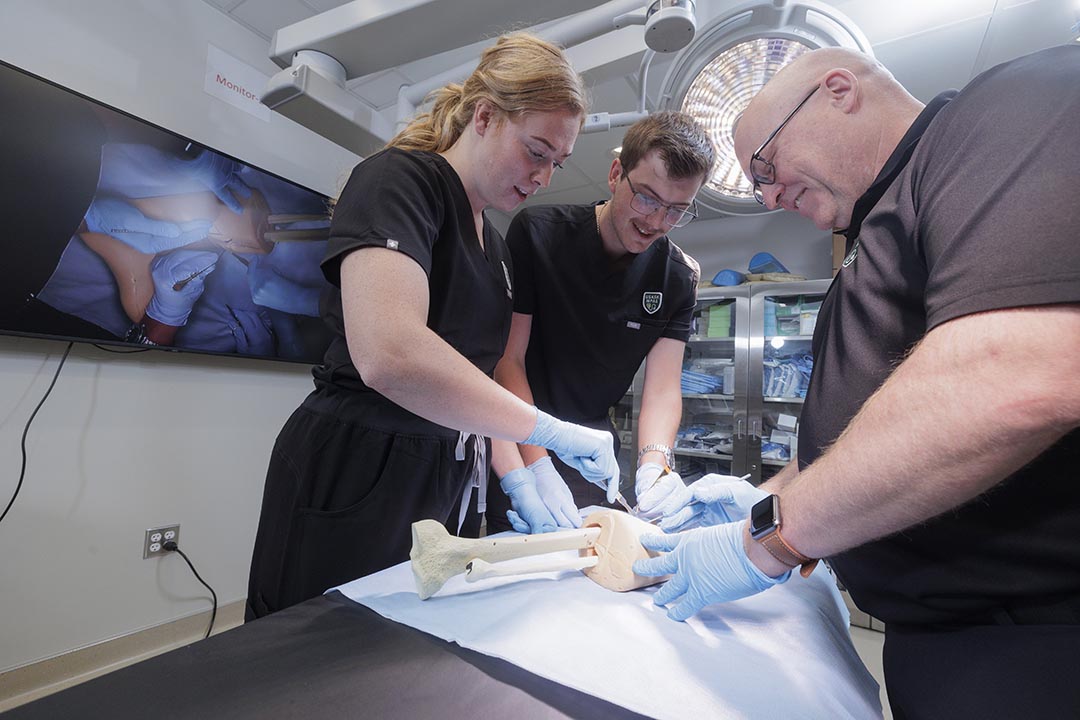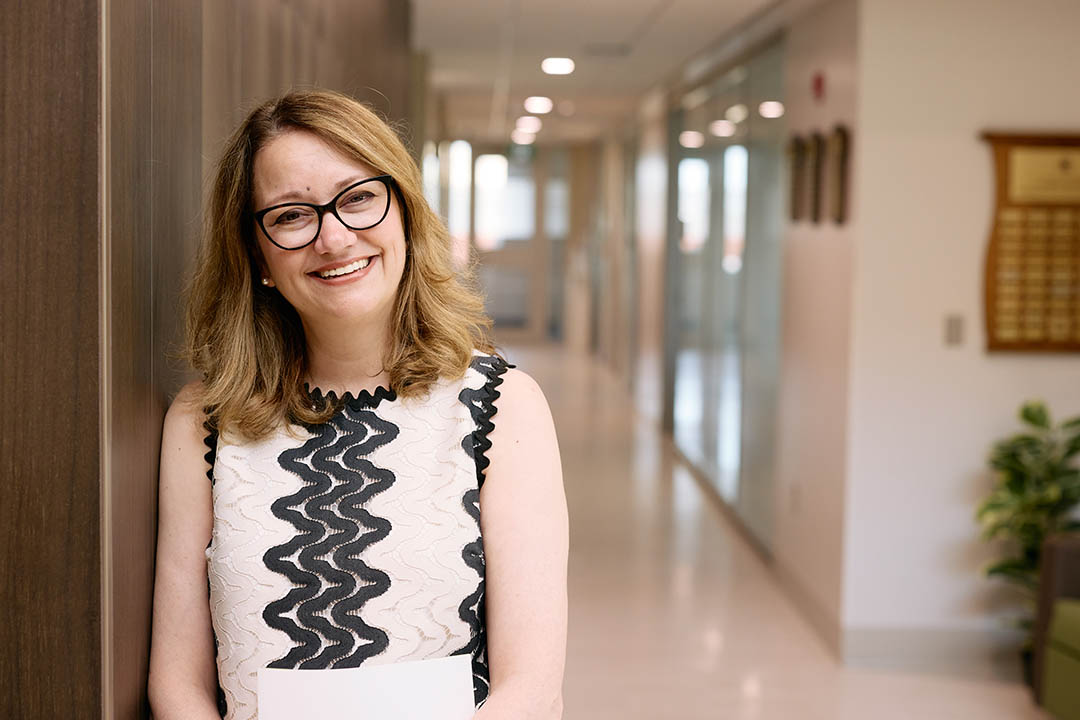
Strengthening community health
Pressure on the health-care system – from factors including workforce shortages, rising costs and an aging population – takes a prominent and hard-to-shift position among Canada's top challenges.
By Globe and Mail Western Schools ReportThe University of Saskatchewan (USask) is taking a proactive approach to finding solutions, including through strategies that advance community-based interventions – and a commitment to research and education that help address local and global health challenges.
"There is a tremendous legacy of innovation and hard work in health care linking the University of Saskatchewan and the College of Medicine to the people of Saskatchewan," says Dr. Sarah Forgie, the university's dean of Medicine. "What's famous about this province is how Tommy Douglas and Wendell McLeod worked together with colleagues to put into place what we now know as universal health care."

The first universal hospital insurance plan – which later became the foundation for the national system – was established in Saskatchewan in 1947 by Tommy Douglas with the advice of Wendell McLeod, who later became the dean of USask.
The guiding principle of ensuring equitable access to health care continues to inform education, research and community outreach at USask, says Dr. Forgie. "When we talk about health care in the province – and efforts to improve health outcomes, we are talking about access to care as well as to health education and prevention."
A focus on prevention encompasses "nutrition, vaccines, exercise and more," she explains. "This means bringing together different areas of expertise – including in kinesiology, pharmacy, public health, nutrition and dentistry – to work together to help make the province healthier."
An interdisciplinary perspective is baked into the university's DNA, says USask President Peter Stoicheff. "Of the group of 15 Canadian research-intensive universities, we're the second smallest. On the flip side, we have 17 colleges and schools. When you have that much multidisciplinary activity on a relatively compact campus, people tend to know each other; they tend to know what's going on, and this really helps with interdisciplinarity."
Dr. Forgie agrees that students and faculty have ample opportunity to mingle – through targeted collaboration opportunities as well as close proximity. The College of Medicine, for example, is housed with other health science disciplines, including pharmacy and nutrition, dentistry, nursing, the schools of public health and rehabilitation science, and kinesiology and veterinary medicine are a short walk away.
"Good ideas tend to happen when different perspectives come together. It's like the primordial sea where the right molecules needed to be present and come together to spark life," she says. "That's something we create here. I love it when I can sit in a room with different health professionals, engineers, mathematicians and philosophers."
Equally important are connections with health authorities and communities, Dr. Forgie says. "We're very collaborative. The confluence of advanced education and public health, for example, is informing research and programming, including new programs in rehabilitation sciences: occupational therapy and speech language pathology."
The impetus of launching these programs "came from practitioners in the community. They said, 'We need made-in-Saskatchewan solutions,'" notes Dr. Forgie. "They brought their advocacy and passion, and the government heard this and provided funding."
This is something about Saskatchewan she has come to value: "the prairie ethic of coming together to move forward on issues that matter."
A collaborative response to local challenges
Among the challenges affecting Canadians across the country is a shortage in physicians, particularly in family medicine, where projections indicate a deficit of nearly 20,000 family doctors by 2031. Rural areas – where only about 8 per cent of physicians serve nearly 20 per cent of the population – fare even worse.
Saskatchewan's population is spread out over a vast geographic area, which Dr. Forgie regards as "a unique opportunity that we're leveraging to provide training as well as care in rural areas, including in Indigenous communities."
For the undergraduate medical program, which recently increased to 108 seats, approximately two-thirds of students train in Saskatoon and the rest in Regina, ensuring distribution in the north and south of the province.
Then, in the third and fourth years of medical school, students can enter SLIC, Saskatchewan Longitudinal Integrated Clerkship, she explains. "Students do their clinical training with colleagues in rural and regional communities all across the province. This gives them an opportunity to learn and see things from different perspectives."
In the family medicine residency program, the government has supported further expansion of placements with physicians working in smaller communities, Dr. Forgie says. "This helps bring care to more rural areas, and we know that many students opt to stay on to practice in these communities."
Another avenue for improving health-care outcomes is to strengthen collaborative care models – and expand the types of professionals providing care, for example, physician assistants.

The ability to contribute to the success of health-care teams across the province, including in rural areas, was part of what drew Rachel Rosin to join the new Master of Physician Assistant Studies (MPAS) program at USask's College of Medicine.
"I'm looking to gain experience in both urban and rural settings," she says. “I was looking for a chance to pivot my career within healthcare and expand my knowledge base, allowing me to broaden the areas I work in both location and area of expertise. The PA career path allowed those changes to happen while still being able to maintain a healthy work-life balance. This is particularly important to me as I enjoy coaching track with a local club.”
Through MPAS, which provides participants with three months rural clinical exposure in addition to nine months in an urban setting during the second year, Ms. Rosin looks forward to "continuing to increase access to education and care while getting to know the different patient groups we'll later work with as practitioners."
Ms. Rosin's passion for athletics, particularly track, led her to complete an undergraduate degree in kinesiology from the University of Alberta. After that, she gained a range of work experiences, including at the Cardiac Catheterization Labs at the Royal University Hospital in Saskatoon, while she worked towards – and completed – her certification as a cardiovascular technologist.
Now, Ms. Rosin is excited to be part of the inaugural MPAS cohort. "When I look around my class, I see a group of leaders," she says. "What really resonates for me is that we get to pave the way for future students."
Research and solutions meeting community needs
The University of Saskatchewan is also a powerhouse in health research, says Dr. Forgie, who specializes in pediatrics and infectious diseases. "I work with so many different people who each have a unique lens and offer something different to help patients.”
"For example, USask has research organizations like VIDO, the Vaccine and Infectious Disease Organization that just celebrated its 50th anniversary. They bring together animal and human health – and develop and manufacture vaccines," she says.
Dr. Forgie advocates for "strengthening connections between different disciplines – and from bench to bedside – so we can take novel therapies into clinical trials and eventually into practice."
An example of mobilizing research to achieve tangible community impact is the Canadian Centre for Rural and Agricultural Health (CCRAH), says Dr. Stoicheff. "I've seen a map of all the places where CCRAH has grassroots, on-the-ground relationships. It covers the entire province and is very impressive."
CCRAH works directly with rural and agricultural people to study – and help address – health and safety needs, says Dr. Forgie. "[Researchers] work with rural communities to proactively check for things like hearing problems and dementia. They also look at the damage that comes from exposure to excessive vibration caused by farming equipment, which can lead to problems with balance and reaction time as well as back and neck pain. One study, called 'Take a break from the shake,' looks at whether short activity breaks can reduce these effects."
Enhancing access to education
Strengthening health outcomes also requires a robust – and inclusive – talent pipeline, says Dr. Stoicheff. "We've been very deliberate in trying to extend our presence across the entire province. For example, we have a campus in Prince Albert, where nursing and dental therapy are among the programs we deliver."
Such efforts are informed by a recognition of the barriers to university education people in rural and remote communities may face if they have to relocate to a major centre. "This can be expensive and disrupt connections to family and community," Dr. Stoicheff says. "We try to be accessible to more people across the province, and particularly the north."
Collaborations and outreach activities, including with Indigenous communities and schools, have already led to stronger outcomes, believes Dr. Forgie, who adds that the College of Medicine "has the country's first vice-dean of Indigenous Health, who is helping engage with Indigenous communities in a positive way, and the first Department of Indigenous Health and Wellness at a Canadian medical school."
Another example is the Indigenous Admissions Pathway that includes "an Indigenous Admissions Circle made up of representatives from the Indigenous community,” she says.
This unique approach to the admissions process – which takes into account what students look for in these programs and what they bring to the community – counts among Saskatchewan-led innovations that are making a difference, states Dr. Forgie.
"What we hope to see in these classes – and subsequently in the practices – are students who represent what we stand for," she adds. "The question that should always be on our mind is how we can improve health outcomes in this province and beyond."

